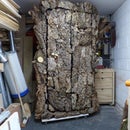Introduction: Microcement Worktops for a Bespoke Kitchen
I've recently finished making a bespoke kitchen for my first flat. As part of the design for it I wanted to do a wrap around worktop which I initially planned to cast in concrete but then changed and opted for something called Microcement. When initially researching this I found a lot of professional companies who would come and install it for you but couldn't find much in the way of DIY advice/kits. I did eventually, and managed to do the worktops so thought I'd share my experience...
Step 1: What/Why Microcement
I had originally planned on trying to cast the worktops in concrete but due to concerns with:
- Complexity of the mold
- Weight
- Cost
- Its porous so can absorb liquids and stain.
I decided to research alternatives and came across something called Microcement.
Microcement (I also found it to be referred to as Micro-topping, Micro-screed) is a composite coating based on a mix of cement, resins, additives and colouring pigments that you apply over a substrate. It seemed to be very versatile and able to be used in a variety of applications, see some of the examples I found in the pics.
Pro's
Its has very good adhesion and can be applied to floors, walls and ceilings. Interior and exterior.
- You can get continuous surfaces without joints, ideal for my wrap around worktop.
- You can get it in a wide variety of colours and textures. I went for white and the satin finish option (matt and gloss were also available)
- Covers all surfaces: tile, stoneware, concrete, plasterboard, wood etc.
- Great resistance to use, shock, scratches and chemicals.
- Impermeable so no staining.
- You can apply it with the substrate installed so no complex mold making etc.
It ends up being ~4mm thick on top of the substrate so is light weight
- Easy maintenance and cleaning
Good cost, I got a 10m2 kit for ~£300 which was enough of my two worktops and some flooring... I thought was good value!
Con's
- It obviously doesn't have the same mass/dense feeling to it that a concrete worktop would have.
Step 2: The Kit and Tools Required
I struggled to find suppliers who offered DIY kits rather than just a professional install service. I did eventually from a company in Spain that offered shipping to the UK.
https://www.latiendadelmicrocemento.com/
***I'm not affiliated with them in any way.. just thought it was a good kit :)
They offer kits in a variety of sizes, 5m2 to 150m2! I had two worktops and a couple bits of flooring I wanted to do, which I worked out to be just under 10m2 so got that kit.
The kits are also specified as floor or wall.. which I think mainly changes whether the top coat material is fine or a bit rougher to be more hardwearing. I went for the floor option.
The kit included pretty much everything you need:
- Microcement Fino - this is the top coat material,
- Microcement Base - this is the base material
- Resin component B - you mix this with the microcement
- Pigments - if you go for anything other than the neutral the pigment gets mixed in to colour the microcement
- Adhesion promoter
- Fiberglass mesh
- Primer sealer
- Polyurethane varnish
- Paint roller
- Mixer
- Small steel trowel
- Sandpaper
- And installation
Other than the tools the kit provides you'll need:
- Drill to mix with
- Plenty of buckets
- Scales to weigh out the ratios
- Newspaper/sheets to cover things you dont want covered
- A breathing mask with filters suitable for dust and high VOC's!
Step 3: Substrate Prep
The Microcement is compatible with being applied on top of a variety of surfaces such as tiles, concrete, plasterboard, wood, old worktop etc.. It seems to just need to be something structurally sound/stable. In my case I opted for 2 layers of 18mm thick MDF as its strong, dimensionally stable and cheap.
I got the DIY store to cut the full sheet of MDF to the correct width for the worktop so I could get it home on the roof of my car. Remember, if you've got a specific final worktop width in mind, 600mm in my case, to make the substrate ~4mm less to account for the Microcement thickness. I then cut the sheets to the correct lengths required and cutout any holes necessary for the gas hob, taps etc. The sink I chose to use is an undermount version and so I could have a drainer integrated into the worktop I routed some channels into the top layer of the MDF using a round nose router bit.
The two layers of MDF were then glued/screwed together, and then attached to the cabinets using screws and L-brackets where required. I also cut additional thinner lengths of MDF to run along the bottom of the cabinet.
I now masked and covered all the areas of the cabinets I didn't want to get the microcement on.
The first step of the microcementing process is to apply a layer of fiberglass mesh onto the substrate. The kit provides a 1m wide roll in a length to suit the size of kit you bought. You need to cut this to the size required to fit the areas you're going to apply the microcement too, then roll over it with the resin provided and leave to dry.
Step 4: Applying the Microcement
Prep:
The instructions provided with the kit give the required mix ratio of the microcement to the resin. Once mixed, the microcement/resin mix has a limited work time so you're going to want to work in smaller batches to avoid it setting before you've used it all. The areas I wanted to cover in microcement split easily into 4.. 2 worktops and 2 separate bits of flooring. I worked out and noted down what weight of microcement and resin I'd need for each of those areas.
Mixing:
You always want to be mixing in a clean bucket or you could risk altering the colour etc. Pour the required amount of resin into the bucket. Top tip, the colouring pigment gets added to the big container of resin so make sure you always shake the resin container well before pouring it out to ensure consistent colour, i think the pigment can settle at the bottom. With the resin in the bucket, you slowly start pouring in the microcement.. much in the way you would mix plaster. A power drill and mixer paddle is then used to mix it up, again to a consistency like you would with plaster.
Applying:
The microcement is applied in 4 stages, 2 base coats and 2 top coats. Each coat took me a couple hours to apply to the 4 areas, it then needs >3hrs to dry before you can sand that down and the next layer can be applied. This means it'll take a few days to get it done.
Each coat is applied like you would plaster.. I've only plastered once before this so watch some youtube videos to see what the techniques like. But essential dump it out on the substrate and smooth it out with the trowel. You want to try get an even thickness over the substrate thats about 1mm for each coat, so you end up with a total thickness of ~4/5mm.
Step 5: Sealing
The final step of the process is to seal the microcement. First you'll want to make sure the surfaces/room are dust free as anything there or that lands in the sealer whilst its wet will show in the final surface
You then roll on two coats of the sealer primer, followed by two coats of the polyurethane sealer.. with ~3hr drying time in-between. Again this took a couple days in total to do with the drying times.
This stuff stank! Very high VOC's! Get a good mask with good chemical filters! Open all windows in the area! Plan a trip to the pub once your done so you can get out the house!
Step 6: Finished
The finished worktops! Overall I'm pleased with the results I got with the material/product. It allowed my to create the modern look I wanted, for a good cost and relatively easy process.
I think it could be used in a number of other ways.. on more complex substrate shapes.. definitely something I'm keeping in mind for future projects.
Hope you enjoyed and maybe discovered a new material for projects!
If you're interested, I have a full video of the kitchen build here:













